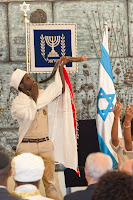 |
| Western Wall in Jerusalem - divided areas for men and women |
Achieving religious pluralism in Israel, where equal rights and recognition is granted to all forms of Judaism, is a becoming a goal for more and more Israelis who are seeking non-Orthodox, spiritual alternatives to secularism (Rosenthal, 241). Adding on an additional goal of struggling for religious equality for women, is the purpose of an o rganization called The Women of the Wall. On their website, Women of the Wall state that their central mission is to achieve the social and legal recognition of their right, as women, to wear prayer shawls, pray and read from the Torah collectively and out loud at the Western Wall in Jerusalem. They work to further their mission through social advocacy, education and empowerment. The majority of Jews living outside of Israel embrace the egalitarian ideals of Conservative, Reform, Reconstructionist and Renewal Judaism, and encourage women to participate fully in all prayer and ritual activities. Orthodox Judaism does not. One of Judaism’s most holy sites for prayer, the Western Wall in Jerusalem, has become a battleground for determined, observant Jewish women who seek the freedom to worship as they please.
rganization called The Women of the Wall. On their website, Women of the Wall state that their central mission is to achieve the social and legal recognition of their right, as women, to wear prayer shawls, pray and read from the Torah collectively and out loud at the Western Wall in Jerusalem. They work to further their mission through social advocacy, education and empowerment. The majority of Jews living outside of Israel embrace the egalitarian ideals of Conservative, Reform, Reconstructionist and Renewal Judaism, and encourage women to participate fully in all prayer and ritual activities. Orthodox Judaism does not. One of Judaism’s most holy sites for prayer, the Western Wall in Jerusalem, has become a battleground for determined, observant Jewish women who seek the freedom to worship as they please.
 rganization called The Women of the Wall. On their website, Women of the Wall state that their central mission is to achieve the social and legal recognition of their right, as women, to wear prayer shawls, pray and read from the Torah collectively and out loud at the Western Wall in Jerusalem. They work to further their mission through social advocacy, education and empowerment. The majority of Jews living outside of Israel embrace the egalitarian ideals of Conservative, Reform, Reconstructionist and Renewal Judaism, and encourage women to participate fully in all prayer and ritual activities. Orthodox Judaism does not. One of Judaism’s most holy sites for prayer, the Western Wall in Jerusalem, has become a battleground for determined, observant Jewish women who seek the freedom to worship as they please.
rganization called The Women of the Wall. On their website, Women of the Wall state that their central mission is to achieve the social and legal recognition of their right, as women, to wear prayer shawls, pray and read from the Torah collectively and out loud at the Western Wall in Jerusalem. They work to further their mission through social advocacy, education and empowerment. The majority of Jews living outside of Israel embrace the egalitarian ideals of Conservative, Reform, Reconstructionist and Renewal Judaism, and encourage women to participate fully in all prayer and ritual activities. Orthodox Judaism does not. One of Judaism’s most holy sites for prayer, the Western Wall in Jerusalem, has become a battleground for determined, observant Jewish women who seek the freedom to worship as they please.  |
| Nofrat Frenkel arrested for carrying Torah |
Women of the Wall gained global publicity when an Israeli nurse, Nofrat Frenkel was arrested last year after attempting to bring out a Torah in the main women’s section at the Western Wall, which is against the law. The Western Wall, which Israel gained back from Jordan after the Six Day War, was a symbol of Jewish survival and pride for all Jews. Today, it is often a site of controversy. “Israelis have given up on the Wall,” said Anat Hoffman, who serves as chairwoman of Women of the Wall. She was also arrested at a Woman of the Wall event six months ago. “They feel uncomfortable there... People have made them feel as if they’re not coming home, but trampling on someone else’s place.” Hoffman is also the executive director of the Israel Religious Action Center which is the public and legal advocacy arm of the Reform Movement in Israel founded with the goals of advancing pluralism in Israeli society and defending the freedoms of conscience, faith, and religion. Both the Women of the Wall and the Israel Religious Action Center are activist movements and advocacy groups so they both present their cases from a very biased point of view. They bring attention to their causes with demonstrations and protests aimed at bringing nationwide and worldwide attention to themselves.
 |
| Women wearing prayer shawls |
If the extent of the Orthodox rabbinate’s control over the lives of Israelis was reduced, there would be a much better chance that women would be allowed to worship along with men at the Wall in Jerusalem, but until that day, the ultra-Orthodox see the actions and demands of the Conservative and Reform Jews as “far more dangerous” than non-observant secular Jews (Rosenthal, 242). Donna Rosenthal quotes Israeli Reform Rabbi Meir Azari’s comments about the ultra-Orthodox control of Jewish law in Israel; “In their eyes, only Orthodox Judaism is kosher, they believe that recognizing us would undermine their monopoly as the Judaism of Israel. Israel is the only democracy in the Western world to deny religious freedom to Jews. What we’re fighting for is the right for Israelis to have the freedom to choose how they want to be Jewish.”(Rosenthal, 242). The animosity between the various religious groups in Israel is a very difficult issue.


